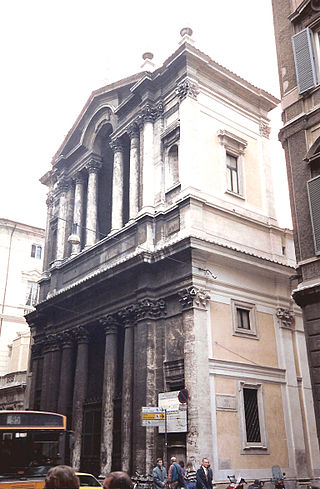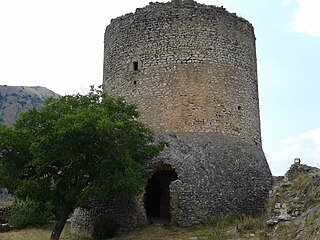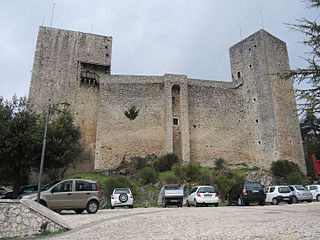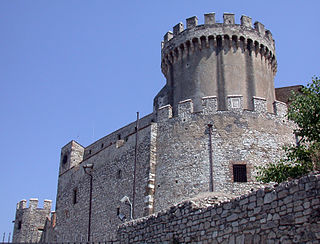| Castle of Oricola | |
|---|---|
Castello di Oricola | |
| Oricola | |
 Castle in Oricola | |
| Type | Castle |
| Site history | |
| Built | 9th century |
Castello di Oricola (Italian for Castle of Oricola) is a medieval castle in Oricola, Province of L'Aquila (Abruzzo). [1]
| Castle of Oricola | |
|---|---|
Castello di Oricola | |
| Oricola | |
 Castle in Oricola | |
| Type | Castle |
| Site history | |
| Built | 9th century |
Castello di Oricola (Italian for Castle of Oricola) is a medieval castle in Oricola, Province of L'Aquila (Abruzzo). [1]

The origin of Oricola Castle dates back to the 9th century when Rainaldo, Counts of Marsi, built a fortress along with other towers connected by walls to defend against the incursions of the Saracens and the Hungarians [2] .
In 1096, the castle passed into the hands of Aldegrina or Aldegrima, daughter of Pandolfo (Prince of Capua), Countess of Carsoli, and wife of another Rainaldo, a descendant of the founder who died during the First Crusade. That same year, she donated it to the Abbey of Montecassino [3] . In 1097, the castle of Auricola (the medieval name of the village) was listed among the properties confirmed by the papal bull of Pope Urban II to Abbot Oderisio di Montecassino. [3]
In 1242, the castle was attacked by Frederick II after the destruction of Carsoli, as he pursued fugitives who had taken refuge in Oricola [4] .
In 1381, Oricola became a fief of the Orsini family, and the castle acquired its contemporary configuration thanks to renovations in the mid-15th century. In 1491, it passed to the Colonna family, but in 1528 the Orsini defeated the Colonna near Magliano de' Marsi, and the castle was sacked and subsequently returned to Orsini control.
In 1557, Oricola and the nearby castles were once again invaded and sacked, this time by the troops of the Duchy of Tagliacozzo and Albe.
The current castle, located in a dominant position on the "piana del Cavaliere", has a triangular plan with three cylindrical towers at the corners. The two towers on the eastern facade have been completely renovated, while the western tower still retains characteristics of the original construction.
The northwest part of the building is occupied by municipal offices, while on the ground floor of the left side of the main facade, there are post office facilities. The rest of the castle is privately owned.

Bracciano is a small town in the Italian region of Lazio, 30 kilometres northwest of Rome. The town is famous for its volcanic lake and for a particularly well-preserved medieval castle Castello Orsini-Odescalchi. The lake is widely used for sailing and is popular with tourists; the castle has hosted a number of events, especially weddings of actors and singers.

The province of L'Aquila is the largest, most mountainous and least densely populated province of the Abruzzo region of Italy. It comprises about half the landmass of Abruzzo and occupies the western part of the region. It has borders with the provinces of Teramo to the north, Pescara and Chieti to the east, Isernia to the south and Frosinone, Rome and Rieti to the west. Its capital is the city of L'Aquila.

Avezzano is a city in the Abruzzo region, province of L'Aquila, Italy. It is the second most populous municipality in the province and the sixth in the region. It is the main commercial, industrial and agricultural centre of the Marsica area, with important high-tech industries and the Fucino Space Centre.

Santa Maria in Via Lata is a church on the Via del Corso, in Rome, Italy. It stands diagonal from the church of San Marcello al Corso.

The Chigi Palace is a palace and former noble residence in Rome which is the seat of the Council of Ministers and the official residence of the Prime Minister of Italy. Since 22 October 2022, the tenant of the Chigi Palace has been Prime Minister Giorgia Meloni, although she does not live in the building. It is located in the Piazza Colonna, next to Palazzo Montecitorio, seat of the Chamber of Deputies.

The Diocese of Avezzano is a Latin diocese of the Catholic Church in central Italy, whose name in Italian was changed in 1986. It was previously known as the Diocese of Marsi, as it still is in Latin. It has been a suffragan of the Archdiocese of L'Aquila since 1972.

Castello Orsini-Odescalchi is a castle in Bracciano, Lazio, Italy. It is located on the southern shore of Lake Bracciano. It was built in the 15th century, and combines the functions of a military defence structure and a civilian residence of the feudal lords of the period, the Orsini and Borgia, both papal families. As one of the largest and best-maintained castles in Italy, it also houses a museum; as a centre of cultural events, the Castello has hosted several high-profile weddings such as those of Tom Cruise/Katie Holmes, Eros Ramazzotti/Michelle Hunziker, and Petra Ecclestone/James Stunt.

Tourism in Abruzzo has become one of the most prosperous sectors in the economy of Abruzzo, and in recent years has seen a remarkable growth attracting numerous tourists from Italy and Europe. According to statistics, in 2021 arrivals totaled 1,330,887. A total of 5,197,765 arrivals were tourists, a figure that puts the region seventeenth among the Italian regions for numbers of tourists per year. A moderate support to tourism is also given to the Abruzzo Airport with many low cost and charter flights connecting the entire region with the rest of Europe.

Rocca Orsini is a Middle Ages castle in Scurcola Marsicana, Province of L'Aquila (Abruzzo).

Castello di Carsoli is a medieval castle in Carsoli, Province of L'Aquila (Abruzzo), central Italy.

Castello di Gagliano Aterno is a Middle Ages castle in Gagliano Aterno, Province of L'Aquila (Abruzzo)..

Castello di Ortona dei Marsi is a Middle Ages castle in Ortona dei Marsi, Province of L'Aquila (Abruzzo).

Castello di Pereto is a Middle Ages castle in Pereto, Province of L'Aquila (Abruzzo), Italy.

Castello di Salle is a Middle Ages castle in Salle, Province of Pescara, Abruzzo, Italy.

The Orsini-Colonna castle is a castle in Avezzano, Province of L'Aquila (Abruzzo).

The Castello Orsini di Nerola or Castello di Nerola is a medieval, Romanesque-style castle situated atop a hill above the town of Nerola in the Province of Rome, Italy. The address is on via Aldo Bigelli. It now functions as a hotel and conference center.

The Piani Palentini is a plateau in upper Marsica, a subregion of Abruzzo, in central Italy.

Michela Ramadori is an Italian art historian, author and academic.
The history of the city of Marino, in the province of Rome, in the Roman Castles area, begins with the appearance of the first human settlements in the municipal territory during the Bronze Age. In the Middle Ages the castle knew its period of greatest splendor under the rule in turn of the Counts of Tusculum, the Frangipane, the Orsini, the Apostolic Chamber, the Caetani, and finally the Colonna, of whom it was a historic stronghold. Marinese events have often been of considerable importance in the local and sometimes even international historical context, so much so that various scholars in various eras have tried their hand at collecting the historical memories of this town. The castle was besieged several times, with mixed results, suffering at least four sackings and two destructions a fundamentis. However, the feudal lords and the community have been concerned at all times to erect monuments for public ornament, such as the only example of Gothic architecture in the Roman Castles, the former church of Santa Lucia, the sanctuary of Santa Maria dell'Acquasanta, the Frangipane and Orsini fortresses, Palazzo Colonna, the collegiate basilica of San Barnaba, Palazzo Matteotti, and many other public works. Numerous important personalities in politics, the arts, religion, and finance were also born, lived, or related in some way in Marino.
{{cite book}}: CS1 maint: location missing publisher (link)